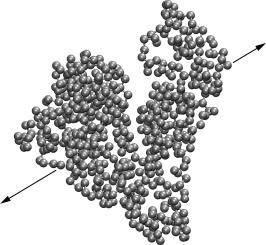当前位置:
X-MOL 学术
›
BBA Gen. Subj.
›
论文详情
Our official English website, www.x-mol.net, welcomes your
feedback! (Note: you will need to create a separate account there.)
Protein mechanics probed using simple molecular models.
Biochimica et Biophysica Acta (BBA) - General Subjects ( IF 2.8 ) Pub Date : 2020-04-13 , DOI: 10.1016/j.bbagen.2020.129613 Matthew Batchelor 1 , Kostas Papachristos 1 , Michele Stofella 1 , Zu Thur Yew 1 , Emanuele Paci 1
Biochimica et Biophysica Acta (BBA) - General Subjects ( IF 2.8 ) Pub Date : 2020-04-13 , DOI: 10.1016/j.bbagen.2020.129613 Matthew Batchelor 1 , Kostas Papachristos 1 , Michele Stofella 1 , Zu Thur Yew 1 , Emanuele Paci 1
Affiliation

|
BACKGROUND
Single-molecule experimental techniques such as optical tweezers or atomic force microscopy are a direct probe of the mechanical unfolding/folding of individual proteins. They are also a means to investigate free energy landscapes. Protein force spectroscopy alone provides limited information; theoretical models relate measurements to thermodynamic and kinetic properties of the protein, but do not reveal atomic level information. By building a molecular model of the protein and probing its properties through numerical simulation, one can gauge the response to an external force for individual interatomic interactions and determine structures along the unfolding pathway. In combination, single-molecule force probes and molecular simulations contribute to uncover the rich behavior of proteins when subjected to mechanical force.
SCOPE OF REVIEW
We focus on how simplified protein models have been instrumental in showing how general properties of the free energy landscape of a protein relate to its response to mechanical perturbations. We discuss the role of simple protein models to explore the complexity of free energy landscapes and highlight important conceptual issues that more chemically accurate models with all-atom representations of proteins and solvent cannot easily address.
MAJOR CONCLUSIONS
Native-centric, coarse-grained models, despite simplifications in chemical detail compared to all-atom models, can reproduce and interpret experimental results. They also highlight instances where the theoretical framework used to interpret single-molecule data is too simple. However, these simple models are not able to reproduce experimental findings where non-native contacts are involved.
GENERAL SIGNIFICANCE
Mechanical forces are ubiquitous in the cell and it is increasingly clear that the way a protein responds to mechanical perturbation is important.
中文翻译:

使用简单的分子模型探测蛋白质力学。
背景技术诸如光镊或原子力显微镜的单分子实验技术是单个蛋白质的机械展开/折叠的直接探针。它们也是研究自由能源格局的一种手段。单用蛋白质力光谱法只能提供有限的信息。理论模型将测量值与蛋白质的热力学和动力学特性相关联,但没有揭示原子水平的信息。通过建立蛋白质的分子模型并通过数值模拟探究其性质,人们可以评估对单个原子间相互作用的外力响应,并确定沿展开路径的结构。结合起来,单分子力探针和分子模拟有助于揭示蛋白质在受到机械力时的丰富行为。综述的范围我们关注简化的蛋白质模型如何发挥作用,以显示蛋白质自由能态的一般性质如何与其对机械扰动的反应相关。我们讨论了简单蛋白质模型的作用,以探索自由能格局的复杂性,并强调了重要的概念性问题,这些问题在化学上更精确,并且蛋白质和溶剂的全原子表示法无法轻易解决。主要结论尽管与全原子模型相比在化学细节上有所简化,但以本机为中心的粗粒度模型仍然可以重现和解释实验结果。它们还突出了用于解释单分子数据的理论框架过于简单的实例。然而,这些简单的模型无法重现涉及非本地联系人的实验结果。一般意义机械力在细胞中无处不在,并且越来越明显的是,蛋白质对机械扰动的反应方式很重要。
更新日期:2020-04-13
中文翻译:

使用简单的分子模型探测蛋白质力学。
背景技术诸如光镊或原子力显微镜的单分子实验技术是单个蛋白质的机械展开/折叠的直接探针。它们也是研究自由能源格局的一种手段。单用蛋白质力光谱法只能提供有限的信息。理论模型将测量值与蛋白质的热力学和动力学特性相关联,但没有揭示原子水平的信息。通过建立蛋白质的分子模型并通过数值模拟探究其性质,人们可以评估对单个原子间相互作用的外力响应,并确定沿展开路径的结构。结合起来,单分子力探针和分子模拟有助于揭示蛋白质在受到机械力时的丰富行为。综述的范围我们关注简化的蛋白质模型如何发挥作用,以显示蛋白质自由能态的一般性质如何与其对机械扰动的反应相关。我们讨论了简单蛋白质模型的作用,以探索自由能格局的复杂性,并强调了重要的概念性问题,这些问题在化学上更精确,并且蛋白质和溶剂的全原子表示法无法轻易解决。主要结论尽管与全原子模型相比在化学细节上有所简化,但以本机为中心的粗粒度模型仍然可以重现和解释实验结果。它们还突出了用于解释单分子数据的理论框架过于简单的实例。然而,这些简单的模型无法重现涉及非本地联系人的实验结果。一般意义机械力在细胞中无处不在,并且越来越明显的是,蛋白质对机械扰动的反应方式很重要。











































 京公网安备 11010802027423号
京公网安备 11010802027423号